Volga aircraft carriers of the Civil War
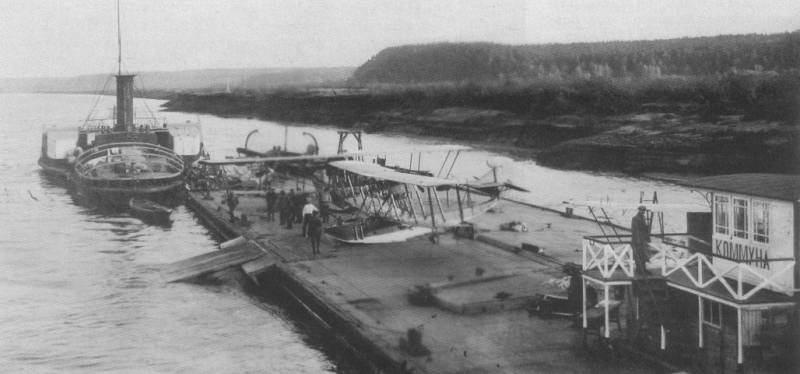
On the deck of the Volga "aircraft carrier" "Commune"
resolution of accumulated social contradictions
inside the state.
Wikipedia
History civil wars. The two most significant civil wars are the War of the North and the South in the United States of 1861-1865. and the Civil War between Whites and Reds in Russia in 1918–1922. left behind an indelible memory. Including about what technical means it was conducted.
Interestingly, despite the difference in almost everything, there is a very real similarity between these two wars: the use of the industrial potential of large cities. In the United States, he was involved in the creation of river and sea battleships, which carried out the sea and river blockade of the southern states. In Russia, river steamers armed with cannons cannot be compared with the battleships of the northerners and southerners. Apparently, neither the level of development of industry in the Volga region, nor the military needs here were such as to bring to life the appearance on the Volga of ships similar to the "brown water battleships", although the Volga warships were armored with bales of cotton.
But on the other hand, the industrial potential of the center was used for the construction of armored trains, which played an extremely important role in the defeat of the White Guards, although they also had armored trains.
But here's what's curious, although battleships were not built on the same Volga, it was there that aircraft carriers were used, which were more in line with the then requirements of the time. Our story is about them today...
And it happened that as soon as the Volga-Caspian military flotillahow airplanes were given to her. But where were they based?
We decided that there is nothing better than transporting them on a large oil barge, and launching them from the water, since these were seaplanes - flying boats designed by Grigorovich M-9.
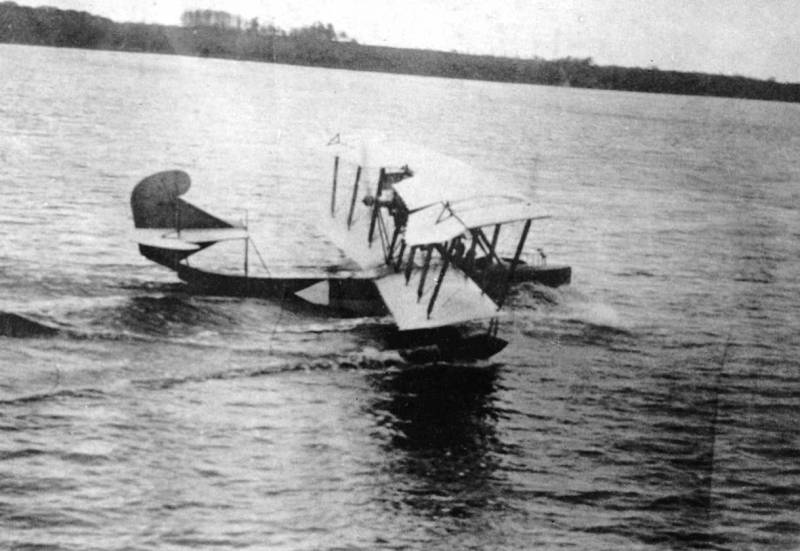
Seaplane M-9 on the water
No sooner said than done. The oil barge "France", renamed the "Commune", was converted into an aircraft carrier. Moreover, not only 6 M-9 seaplanes, but also three wheeled Nieuport-17s were placed on the deck of the barge. It was so long and spacious!
From the point of view of technology, the most difficult thing was to ensure the descent of seaplanes into the water and, accordingly, their return to the barge. The simplest, although not the best solution, turned out to be cranes. With their help, the aircraft was hooked with cables to the wings and taken overboard, after which it was lowered into the water, from which it took off.
On other barges, on the sides or stern, gentle wooden descents into the water were arranged, along which flying boats were pushed into the water, and upon return they were pulled onto the deck. In the Volga-Caspian flotilla, thus, four barges were converted into "aircraft carriers".
The length of the same barge "Commune" was 139,77 m with a width of 19,08 m. The mast and pipes protruding from the deck for pouring oil into Tanks were removed from her. They came up with for greater convenience of descent of aircraft to fill part of the hull compartments with water. At the same time, the draft increased, and the wooden gangways warmed up more strongly. The descent of the aircraft was carried out by a team of 10 people.
It is interesting that the red sailors also took care of arming this barge in case of an attack by enemy aircraft: two 37-mm anti-aircraft guns and several machine guns were installed on it.
The barge "Freedom" had a length of 104,9 m and a width of 15,9 m and could accommodate six M-9 aircraft. The descent and recovery of aircraft from each side was carried out by two rotary cranes.
On the third barge "Poseidon" (94,5 m by 15,22 m) a wooden descent was arranged at the stern. To launch aircraft into the water, the aft compartments of the barge were filled with water, and it settled so that the aircraft could be pushed into the water without much difficulty.
A big drawback of all Soviet Volga aircraft carriers was the lack of hangars on them. The planes were open on the decks and exposed to the elements, which led to their rapid wear. Therefore, in 1919-1920. at the Sormovo plant, the Death barge (length 153,7 m, width 23,5 m) was equipped with hangars. Her upper deck was cleared of all protruding parts, sewn up with boards and two wooden hangars were placed, accommodating up to 10 M-9 flying boats. There was enough space between them to take planes out of them and launch them along the slipways.
Since all the Volga aircraft carriers were not self-propelled, they had to be towed by towing ships attached to them, which, of course, affected their speed, especially when the ships had to go up the Volga, that is, against the current. They were in tow behind the "aircraft carriers" and a goose barge, on which there were ammunition for aircraft.
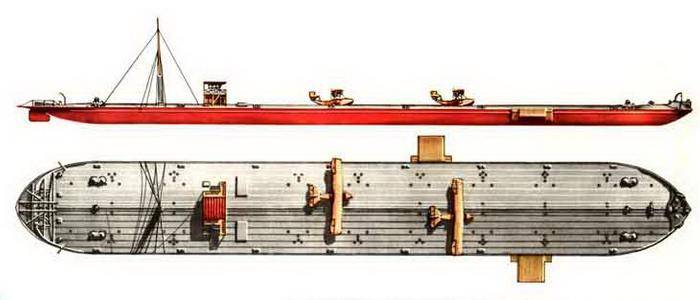
The appearance of the barge-aircraft carrier. Drawing from the magazine "Model Designer" No. 10, 1981
It should be noted that although there were not so many aircraft based on aircraft carrier barges, they actively participated in the battles with the White Guards. First of all, they flew out for reconnaissance, which helped to identify white batteries camouflaged on the right bank, covered with dense vegetation, which caused a lot of trouble to the red ships.
Having found out the location of the battery, the pilots often bombed it themselves, dropping small bombs on them, and fired from machine guns, but most importantly, they transmitted its coordinates to the floating batteries, armed with large-caliber guns, which shot the positions of the whites from afar.
And they could not successfully respond to their fire, since, as a rule, they had only 76,2-mm cannons from the Obukhov plant.
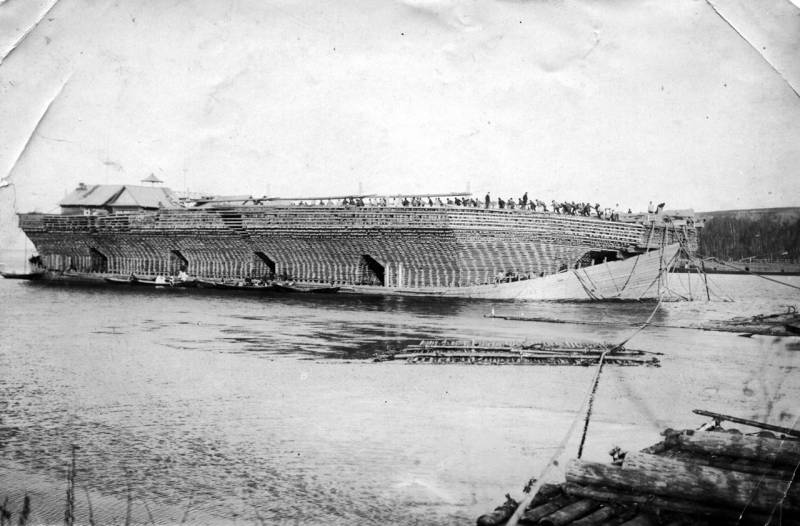
Volga belyana. For some reason, it never occurred to anyone that on the basis of this vessel it is possible to create a completely unsinkable aircraft carrier for wheeled airplanes ...
Second view weapons, very widely used at that time, were combat arrows. They were counted in pounds, loaded into special boxes, or even just bags, and, gaining height, dumped their contents overboard. When falling from a height of about a thousand meters, the arrow acquired such speed that it pierced, hitting the head, through a person sitting on a horse. Enemy airplanes also suffered great damage if they were able to lie in wait at the airfield. Arrows pierced through them and easily disabled their equipment.
And, of course, our red warplanes dropped leaflets on the enemy. This was considered an important part of combat work, and sometimes bombs, arrows, and leaflets were dropped almost simultaneously in one flight.
The Whites liked the idea of the Reds, and at the beginning of the summer of 1919 they decided in Perm to convert the Danilikha wooden barge into an “airplane”. They equipped it with a hangar into four sections, each of which housed one M-9 aircraft. The hangars were closed on both sides with light wooden gates sliding along the rails. The descents also moved along the rails, which were attached to the sides. Since the slopes slid along the sides, they could be moved to any desired section, which, of course, was very convenient.
But this air barge did not have to make war. Already in July 1919, the Danilikha in Perm was captured by the Reds, and then, retreating, they simply burned it.
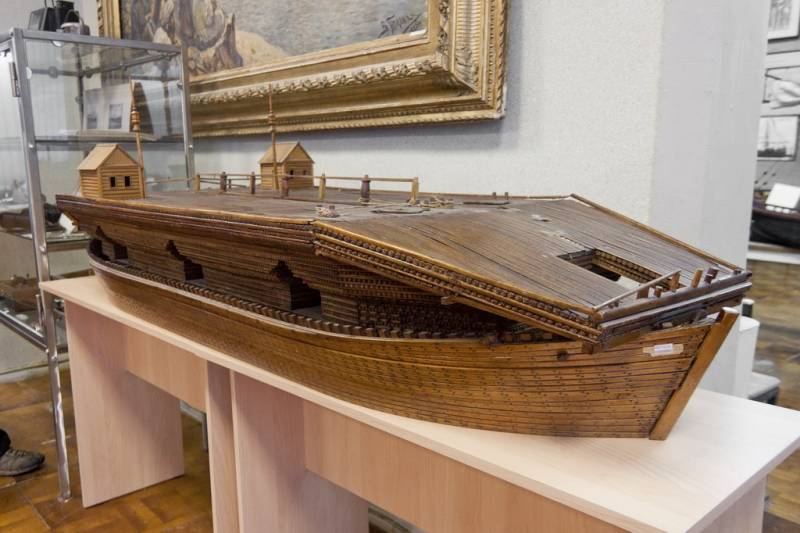
Belyana model in the Saratov Museum
Although the Civil War ended, its experience came in handy in 1928, when the Whirlwind turret gunboat was converted into a non-self-propelled air transport on the Amur, on which four MP-1 seaplanes were based. They named him "Cupid".
The deck was cleared of superstructures, leaving only the armored wheelhouse. And for the planes they arranged a large hangar. In addition, warehouses and workshops were equipped, and living quarters for personnel. It is interesting that the rear wall of the hangar, which leans down on cables, served as a slipway for launching aircraft into the water.
But in 1933, the Amur was renamed again, this time to the Far Eastern Komsomolets, and again turned into a gunboat.
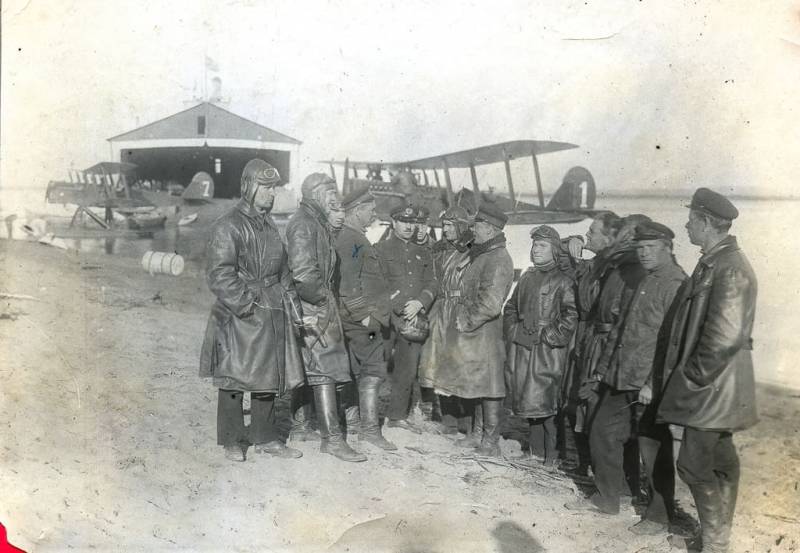
But nevertheless, the aircraft based on the "Amur" contributed to the fighting of the Red Army in the area. They flew out several times to bombard the positions of the "White Chinese", and during the landing of the Red Army troops on the shore, they scattered the enemy cavalry detachment with machine-gun fire, trying to attack the paratroopers.
It is clear that the armament of the scouts was very weak, but, be that as it may, the enemy, who did not expect an attack from the air, suffered serious losses.
True, in the future, the experience of creating river aircraft carriers based on oil barges clearly did not justify itself, and during the Great Patriotic War nothing of the kind was created either on the Volga or in other places. Enough and ground airfields.
Information